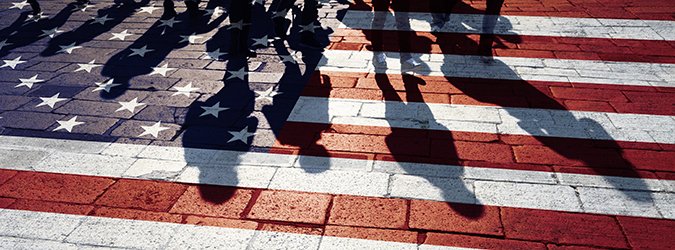Refugees in Upstate New York: A Little-Known Success Story
10.5.2021
As the national debate over immigration continues and intensifies, the question of whether refugees contribute to a community’s vitality or drain the community’s resources continues to be debated. The more than 1,000 Afghani refugees likely to be resettled in upstate New York has again brought the issue to the fore.
Recognizing the challenges posed to upstate New York, several years ago the New York State Bar Association considered initiatives that might strengthen our upstate communities. Beginning with its Task Force on Rural Justice, followed by its examination of immigrant rights in its book “Is America Fulfilling Its Promise? Safeguarding Legal Protection for Immigrants,” it became increasingly apparent that the declining population in upstate New York was imperiling the region’s economic recovery and capacity to maintain basic infrastructure services in academia, health care and programs for retired adults. Reversing the population decline seemed daunting but, to our surprise, it appeared the resettlement of refugees had increasingly become the means to strengthen and often grow these communities, demographically, economically and culturally. And so, we turned our attention to the question of the impact of refugees in upstate New York and to what extent have they contributed to the region’s vitality.
The New York State Bar Association joined with the Government Law Center at Albany Law School and Rockefeller Institute of Government to tackle the question and invited 30 authorities to assemble data and provide perspectives. Their findings have been collected in a new book, “Immigration: Key to the Future – The Benefits of Resettlement to Upstate New York.”
Drawn from academia, the business community, service organizations and the community of statisticians and demographers largely using economic and statistical analysis, our contributors’ findings were consistent. Offsetting the demographic and economic decline in upstate New York communities, refugees pay taxes, rebuild housing stock, open stores, take unfilled jobs and more. Their contributions are so important that an increasing number of localities are seeking to lure refugees who have settled in other parts of the country. As the authors noted, it takes time, support, and patience, but refugees are helping to rejuvenate upstate communities.
Here are some of the more compelling findings in the book.
It begins with what appears to be an anomaly. New York is a cultural and political mosaic. Downstate culturally left of center, while upstate, less populated, and often more conservative. Against this backdrop, the federal government, which determines where resettlement occurs, directed that on the average 6% of the refugees admitted to the U.S. since 2000 be resettled in New York State (third in the nation, only slightly behind California and Arizona) and of that number 90% be resettled in upstate New York.
Cynics said that introducing thousands of refugees into upstate communities would be a combustible combination. Indeed, they were correct; combustion followed, but in a form that appeared to release an energy that buoyed these localities.
Yet, cynicism lingered, voiced by some less familiar with the host communities and those in Washington who struggled to understand the benefits of refugee resettlement. How could small cities and communities in Upstate New York, and not in one community or two, but in well more than half the Upstate counties, benefit from the Bengalis, Bhutanese, Bosnians, Burmese, Guyanese, Jamaicans, Vietnamese, Syrians, Iraqis, Somalians, Asians, South and Central Americans, and of course, the Afghan community, which will likely materially increase in the short term?
The Law
Immigration and tax law appear to be distinguished by the same quality – complexity – and, in each, confusion often abounds. As the national debate over immigration intensified, immigration concepts blurred and the public debate at times became untethered to the law. In brief, migrants and refugees are two of the terms used to describe people who are seeking new homes in other countries. The principal difference is choice. A migrant is someone who theoretically chooses to move to a new country for economic reasons or family ties, and a refugee is unable or unwilling to return their country of origin owing to a “well-founded fear of being persecuted by reasons of race, religion, nationality, membership in a particular social group or political opinion.” The distinction can be porous but key differences remain. Refugees are protected by international law and subject to asylum procedures that include demonstrating evidence of their concern and a long pre-admissions process.
Those who seek refugee status may apply outside of the United States (§ 207 INA) or may apply if they already are in the United States (§ 297 INA). Each refugee is subject to multiple interviews, extensive medical and security clearances, including biometric and biographic checks. The length of the asylum process typically takes between six months and several years. While awaiting approval an asylum seeker may receive work authorization.
Unlike migrants, the federal government chooses where refugees will be resettled. After a refugee has been conditionally accepted, the federal government, in coordination with nine national refugee resettlement agencies, chooses the resettlement location. As noted earlier, in New York State about 90% of refugees are settled upstate; in comparison, 87% of migrants choose to settle in New York City and its environs.
Demographic Impact of Refugees Upstate
Demographic changes over the past decade have pushed U.S. population growth, and growth in many industrialized nations, to its slowest pace since the Great Depression. In half of the states in the U.S., more people died than were born. Compounding the concern is the rapid aging of the population that has pushed the senior population to historic heights. The population of those age 65 and over is projected to move from 13% in 2007 to 20% in 2027. In short, there will be fewer workers supporting services for a greater number of older residents.
Demographic challenges are not distributed evenly across the United States. Some parts of the country added people at a healthy pace, particularly in the southern and western regions of the nation. The 2020 census reflects, however, that New York was only one of seven states to lose a congressional seat based upon the slower growth in population.
For upstate New York, the demographic impact has been particularly pronounced. Forty-two of 50 upstate counties recorded a loss of population of 107,707 between 2010 and 2018. One measure of the demographic health region is the old-age inverse, the number of people at working age required to provide for one retired person or child. A high ratio means that the economy can easily provide for its youths and older population. A low ratio means conversely that a greater burden is placed on its working population and the economy. In upstate New York on balance, the ratio is approaching 3:1, a number which will make it increasingly challenging to sustain services and attract businesses.
On the other side of the ledger, the resettlement of refugees has demonstrably slowed population decline in many upstate areas. Since 2002, more than 50,000 refugees have been resettled in towns and cities throughout upstate. For example, from 1910 to 2000, Utica, a small industrial city northwest of Albany, lost almost half its population. Since 1981, the city has resettled over 16,500 refugees from Bosnia and 30 other nations, which has demographically and economically helped stabilize the city and reverse its population decline. Today 40 languages are spoken in the Utica City School District and 19.4% of the population are foreign-born residents. Utica is not alone; today, three of New York’s upstate city areas are in the top 50 metro areas in the nation for refugee resettlement: Buffalo (#13), Syracuse (#20) and Rochester (#32). In more rural areas, immigrants continue to play a central role in the agricultural economy.
The Economic Impact
While offsetting demographic decline is important, it is fair to ask about the tangible contributions made by the resettled refugee population, and our authors did just that. Some of their findings:
- In upstate New York, immigrants (the vast majority are refugees) in 2018 made up 6.5% of the population but contributed 8% of the GDP, provided 7.7% of the spending power and made up 8.6% of all entrepreneurs.
- Similarly, in 2018, immigrants upstate had an aggregate annual income of $15.2 billion, paid $3 billion in federal income taxes, $1.9 billion in state and local taxes, $1.4 billion in Social Security and $379 million in Medicare.
- Immigrants have had a favorable impact on housing, particularly the renovation of depressed real estate. In Utica, for every 1,000 immigrants who moved into the city, housing prices went up by $116. It is estimated that in Syracuse, immigrants raised housing values by $406.5 million between 2000 and 2014.
- Generally, immigrants fill both low-skilled and higher-skilled jobs. In 2014 alone, immigrants helped create or save 5,000 manufacturing jobs between Buffalo and Syracuse. In 2018, immigrants accounted for 34% of all self-employed New York residents, generating $7.8 billion in business income. In New York State, immigrants make up 9.1% of agricultural jobs, 8.2% of social service and health care jobs and 8.2% of professional service jobs.
- In upstate New York, foreign-born students make up 50% or more of all recent recipients of engineering, mathematics, computer science and economic doctorates. In 2018 and 2019, there were more than 36,000 international students attending colleges and universities in Upstate New York, and they added more than $1.3 billion in consumer spending and supported 16,000 local jobs.
- When refugees arrive, they often have no meaningful independent financial support and rely on public benefit programs. While some programs are funded by the federal government, counties typically advance 25% of the cost of such programs, including Temporary Assistance for Needy Families and Medicaid. The single largest cost for the host counties is English-language training.
The success of refugees and migrants upstate is not without its issues. While their economic trajectory is, as with immigrant groups since the inception of our nation, upward, success can be quick or can take years. Our authors have identified programmatic and regulatory reforms that should promote successful resettlement and accelerate the contribution of new residents including:
At the State Level
(i) Expand its current workforce development programs and, for employers, the Work Opportunity Tax Credit;
(ii) Allow regional development councils to embrace refugee resettlement as an economic development tool and provide the requisite funding;
(iii) Enhance linguistic assistance for communities;
(iv) Reduce barriers to re-credentialing and facilitate the acquisition of new licenses and credentials;
(v) Encourage resettlement of additional refugees and those who may have initially resettled in other states;
(vi) Enhance regional mentoring networks; and
(vii) Take measures to promote naturalization (thousands of immigrants in upstate New York are potentially eligible to be naturalized).
At the Federal Level
(i) Increase the number of refugees and Special Immigrant Visa holders for resettlement in upstate New York;
(ii) Adopt a system of state-sponsored, placed-based visas to attract workers to communities;
(iii) Provide an agriculturally based refugee category;
(iv) Increase funding for resettlement programs;
(v) Expand the Small Business Administration’s mentoring program, and
(vi) Expand the Work Opportunity Tax Credit for employers.
Conclusion
Perspectives and myths abound about refugees and migrants. They are powerful because, on one hand, they tap into fears about jobs and changing communities and, on the other, promoting resettlement of refugees is key to our nation’s future growth and gives voice to our essential compassion. For the book, we asked our experts to premise their analysis on readily accessible data. If anyone takes issue with the underlying data or its interpretation, we welcome your views. In the end, we hope that “Immigration: Key to the Future” stands as an important statement on the contributions made by refugees to their adopted communities. Ideally, it provides adequate data to replace myths and suppositions with an array of facts that are compelling, persuasive and positive.
Sources
As mentioned, the data, referenced in this article is drawn from the articles in “Immigration: Key to the Future.” The contributors to that publication are: Jonathan P. Alba, Bilge Avci, Ava Ayers, Patrick Benjamin, Shelly Callahan, Camilla Campisi, Elizabeth G. Carrature, Matt DeLaus, Kyle Farbry, Scott Fein, Matthew K. Geiling, Laura Gonzalez-Murphy, Paul Hagstrom, Matthew Hall, James E. Jarrett, David Dyssegaard Kallick, Matt Kammer-Kerwick, J. Bruce Kellison, Rey Koslowski, Andrew Lim, Camille J. Mackler, Arthur B. Markman, Anna Mongo, Jenny M. Munoz, Faith Nibbs, Tattiana Padilla, Gregory P. Pogue, Ken Pokalsky, Dina Refki, Richard Rifkin, Sarah Rogerson, Julieta Schiffino, Laura Schultz, Rex Smith, Rhiannon Snide, Hourie Tafech, Jan Vink, Nan Wu, and Katia Yagnik.
Scott Fein is a partner at Whiteman Osterman and Hanna, senior advisor and fellow at the Rockefeller Institute of Government’s Center for Law and Policy Solutions and editor-in-chief of “Immigration: Key to the Future” (NYSBA, 2021).
For more information and to purchase the book, please visit: nysba.org/products/immigration-key-to-the-future/.






